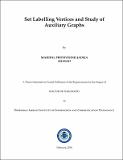Set labelling vertices and study of auxiliary graphs
Abstract
Given a set of nonempty subsets of some universal set, their intersection graph is defined as the graph with one vertex for each set and two vertices are adjacent precisely when their representing sets have non-empty intersection. Sometimes these sets are finite, but in many well known examples like geometric graphs (including interval graphs) they are infinite. One can also study the reverse problem of expressing the vertices of a given graph as distinct sets in such a way that adjacency coincides with intersection of the corresponding sets. The sets are usually required to conform to some template, depending on the problem, to be either a finite set, or some geometric set like intervals, circles, discs, cubes etc. The problem of representing a graph as an intersection graph of sets was first introduced by Erdos et al. and they looked at minimising the underlying universal set necessary to represent any given graph. In that paper it was shown that the problem is NP complete. In this thesis, we study a natural variant of this problem which is to consider graphs where vertices represent distinct sets and adjacency coincides with disjointness. Although this is nearly the same problem on the complement graph, for specific families of graphs this is a more natural way of viewing it. The parameters we take into account are the minimum universe size possible (USN), the minimum individual label size possible (ILN) and their uniform versions (UUSN and UILN respectively). We propose two applications related to information visualization which use the same underlying idea: assignment of unique labels to each vertex of a graph (or tree) and removal of all edges. A pair of nodes is adjacent if and only if their corresponding labels are disjoint. The proposed labelling scheme can be used to establish isomorphism and study of ontologies. Information visualization is a class of techniques which is used to present data in a graphical or pictorial format. Identification of new patterns as well as an understanding of difficult concepts is possible with the proper use of visualization. Using interactive visualization, various other details related to the information can be obtained. We consider trees in which each node is related to a leaf node (object) of taxonomy. We propose a new technique of visualization namely Labeled Object Treemap for the visualization of multiple hierarchies. The comparison of our proposed technique with already known techniques is also made. The total number of distinct elements used in the underlying labelling is asymptotically minimised in the case of k-ary object trees. The motivation for selecting set labelling is to use cardinalities of labels to identify level numbers of the underlying binary tree using which it will be easier to discover adjacency as well as non-adjacency for all vertices. Our main contribution is the development of a new visualization technique which solves the issues of edge crossing and continuity of the 'Trees in a treemap' visualization technique,while maintaining all the good characteristics of existing methods for visualizing multiple hierarchies. We have also implemented an interactive version of the proposed visualization technique with various features and studied various aspects of treemapping. Graph Visualization is one of the sub-fields of information visualization. Itis used for the visualization of structured data. i.e. for inherently related data elements. In the traditional graph visualization techniques, nodes are used to represent data elements whereas edges are used to represent relations. According to us, the key challenges for any graph based visualization technique are related to the edges. Some of the challenges are planar representation, minimisation of edge crossing, minimising the number of bends, distinguish between the vertices and the edges. The biggest advantage of our proposed representations is that they don't have edges so we don't need to consider the challenges related to edges. An algorithm for obtaining a valid labelling as well as procedures related to dynamic changes (addition/removal of edges and/or vertices) are explained in detail. Space complexities of the proposed methods are O(n2) and O(n3) where n denotes the number of nodes. Application of our proposed methods in the analysis of a social network site is also demonstrated. Characteristics of these methods are highlighted along with future possible modifications.
Graphs constructed to translate some graph problem into another graph problem are usually called auxiliary graphs. Specifically, total graphs of simple graphs are used to translate the total coloring problem of the original graph into a vertex coloring problem of the transformed graph. We obtain a new characterisation of total graphs of simple graphs. We also design algorithms to compute the inverse total graph when the input graph is a total graph. These results improve upon the work of Behzad (in terms of simplicity of the algorithm, not running time), by using novelbservations on the properties of the local structure in the neighbourhood of each vertex. We obtain direct constructive results for total graph ofcomplete graphs. The second class of auxiliary graphs which we consider is based on the set of spanning trees of the given graph and the edges constituting those spanning trees. We call this class spanning tree auxiliary graphs of simple graphs. Since the class of spanning tree auxiliary graphs of graphs do not have unique preimages (the forward function is not injective), we derive precisely the classes of graphs which have the same auxiliary graph. We design algorithmic ideas for computing a basic preimage and define rules to get other solutions for the same auxiliary graph. We also obtain several results expressing parameters of the auxiliary graph in terms of (not necessarily the same) parameters of the original graph.
Collections
- PhD Theses [87]

